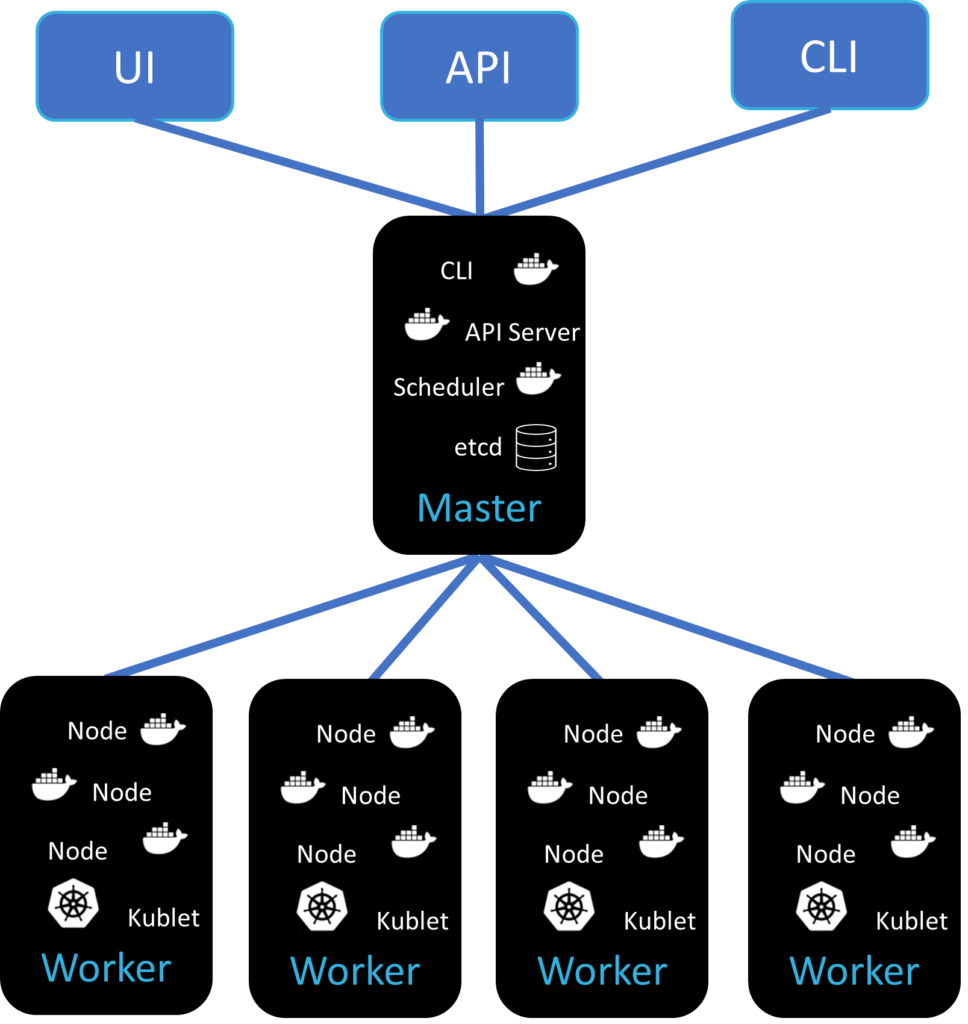Docker and Kubernetes are both essential tools in the world of containerization and container orchestration, but they serve different purposes and can often complement each other.
Docker
Docker is an open-source platform for developing, shipping and running applications in containers. Containers are lightweight, portable, and self-sufficient environments that include an application and all its dependencies, such as libraries and configuration files. Docker makes it easier to package and distribute applications across different computing environments, from development and testing to production.
Key Advantages of Docker
Containerization Technology: Docker is primarily a containerization platform. It allows you to package applications and their dependencies into containers for consistent and portable deployment.
Developer-Centric: Docker is developer-friendly and is often used for local development and testing. Developers can create and share container images easily.
Single Host: Docker is designed for running containers on a single host. It's ideal for smaller-scale applications or microservices.
Simplicity: Docker is straightforward to set up and use, making it a good choice for individuals or small teams working on single-host applications.
Architecture of Docker

Docker Client: The Docker client is the primary way users interact with Docker. It sends commands to the Docker daemon, which can run locally or connect to a remote Docker daemon.
Docker Daemon: The Docker daemon is responsible for managing Docker containers. It listens for Docker API requests and performs tasks like building, running, and distributing containers. It can run on the same host as the Docker client or on a remote host.
Docker Images: Docker images are lightweight, stand-alone, and executable packages that contain application code, libraries, and dependencies needed to run an application. Images are used as the basis for running containers.
Docker Containers: Containers are instances of Docker images. They are running or stopped instances of applications, isolated from the host system and other containers. Containers run in isolated environments but share the same kernel as the host.
Docker Registries: Docker registries are repositories for Docker images. The Docker Hub is a public registry where you can find a vast number of images. You can also create private registries to store and distribute your own images.
Docker Compose: Docker Compose is a tool for defining and running multi-container Docker applications. It uses a YAML file to configure the services, networks, and volumes for your application.
Docker Networking: Docker provides various network modes that enable containers to communicate with each other and the external world. You can create custom networks and attach containers to them for isolation or connectivity purposes.
Docker Volumes: Docker volumes are used for persistent data storage. They allow data to be shared between containers, and they can also be used to store data separately from the container file system.
Dockerfile: A Dockerfile is a script that defines the instructions for building a Docker image. It specifies the base image, application code, dependencies, and configurations.
Docker Engine: The Docker Engine is a combination of the Docker daemon, the Docker client, and other Docker tools and services. It provides a complete runtime environment for containers.
Docker's architecture allows for flexibility, scalability, and ease of use when it comes to containerization. Users can build, ship, and run applications consistently across various environments, making it a popular choice for containerization in the world of software development and deployment.
Docker Swarm
Docker Swarm, often referred to as Docker Swarm Mode, is a native clustering and orchestration solution for Docker containers. It allows you to create and manage a cluster of Docker nodes, providing high availability, load balancing, and service scaling for containerized applications. It is a container orchestration tool.
Key Advantages of Docker Swarm:
Simplicity: Docker Swarm is easier to set up and manage compared to Kubernetes. It's designed for simplicity and is a good choice for smaller-scale container deployments.
Native Docker: Docker Swarm is tightly integrated with Docker. If you're already familiar with Docker, you'll find it easier to work with Swarm.
Single Host or Multi-Host: While it can manage multi-host setups, Docker Swarm is often used for smaller, single-host or less complex applications. It doesn't have all the features of Kubernetes for managing large and complex deployments.
Built-in Load Balancing: Docker Swarm has built-in load balancing to distribute traffic across containers.
Automatic Load Balancing: It provides automatic load balancing when you scale services.
Architecture of Docker Swarm

Docker Swarm Manager: In a Docker Swarm cluster, one or more nodes are designated as managers. These managers act as the control plane for the swarm, responsible for orchestration, scheduling, and communication with worker nodes.
Docker Swarm Workers: Worker nodes are responsible for running containers. They execute the tasks assigned by the swarm manager. You can have multiple worker nodes in a swarm to distribute container workloads.
Swarm Service: A service is the definition of a task that should be run in the swarm. It specifies the container image, number of replicas, resource constraints, network settings, and other configurations.
Task: A task represents a running container associated with a service. The swarm manager schedules tasks to run on worker nodes based on the service's desired state.
Overlay Network: Docker Swarm uses overlay networks to enable communication between containers running on different nodes. This allows containers to connect to each other regardless of their physical location.
Load Balancing: Docker Swarm provides built-in load balancing for services. Ingress load balancing routes external traffic to the appropriate containers within the swarm.
Swarm State Store: Swarm managers store the cluster's state information. This state information includes service definitions, tasks, and configurations. It can be stored in a distributed key-value store or a database.
Consensus Algorithm: Docker Swarm uses a consensus algorithm to maintain cluster integrity. This ensures that managers agree on the swarm state and handle failover gracefully.
The architecture of Docker Swarm is designed to be simple and user-friendly. It provides a relatively lightweight and straightforward way to manage container orchestration, making it suitable for smaller to medium-sized applications and environments. Larger and more complex deployments often opt for Kubernetes due to its advanced features and extensive ecosystem.
Kubernetes
Kubernetes is an open-source container orchestration platform that automates the deployment, scaling, and management of containerized applications. It provides resilience, scalability, and agility in modern, cloud-native development, simplifying the management of complex microservices architectures.
Architecture of Kubernetes

Kubernetes cluster made with at least one Master Node and n-number of worker nodes. In each worker node Kubelet process running. This process helps to communicate and execute tasks. Each worker node has containers of different applications deployed on it. We will go deep diving into it in upcoming articles.
Kubernetes Vs Docker and Docker Swarm:
Robust Orchestration: Kubernetes is a powerful and highly extensible container orchestration platform. It's well-suited for complex, large-scale, and high-availability applications.
Extensive Ecosystem: Kubernetes has a rich ecosystem of tools, extensions, and community support. It's widely adopted and has a broad range of resources available.
Declarative Configuration: Kubernetes uses a declarative approach to manage containerized applications. You describe the desired state, and Kubernetes works to make it so.
Scalability and Resilience: Kubernetes offers advanced features for scaling applications, rolling updates, and managing the resilience of your services.
Multi-Cloud and Hybrid Cloud Support: Kubernetes is often chosen when you need to run containerized applications across different cloud providers or in hybrid cloud environments.
Container Orchestration: Kubernetes is an orchestration platform that manages the deployment, scaling, and operation of containerized applications. It's built for complex, multi-container, and multi-node applications.
Operations-Centric: Kubernetes is more focused on operations and is used to manage containerized applications in production environments.
Multi-Node and Scaling: Kubernetes can manage containers across multiple nodes and provides automated scaling, load balancing, and self-healing capabilities.
Complexity: Kubernetes can be complex to set up and configure, making it more suitable for larger, production-grade applications.
Summary
In summary, Docker is great for containerizing applications and is often used in the early stages of development. Docker Swarm is a simpler, more lightweight solution suitable for smaller or less complex applications, while Kubernetes is a feature-rich, production-grade platform for managing complex, large-scale containerized applications. The choice between the two depends on the specific needs and complexity of your application and your familiarity with the tools. Many organizations choose Kubernetes for its robust features and scalability when building enterprise-grade containerized applications.

